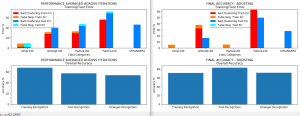This week I worked on training the classifier on AWS. I set up my AWS, including setting up the environment to be able to run my code. I am training with a dataset of 10k negative and 8k positive images, selecting 400 classifiers. I also incorporated hard negative mining. Specifically, I take any false positives in the test set and add those negative example to my training set. The training is still going on, and should be complete by beginning of the week. Additionally, I began writing code for the cascading classifiers in order to increase detection speeds. Previously, it took around 4seconds to detect all the faces in an image. I optimize this by parallelizing the sliding window search, and hope to further increase performance by using cascading classifiers.
Once the classifier has been trained, I will incorporate my facial detector into the mvp. This should be done by early next week. After this, I will work on improving accuracy for hand detection. Overall, I am slightly behind, but this is mostly because the classifier takes extremely long to train (a couple days). This has hindered my progress the past couple weeks.




